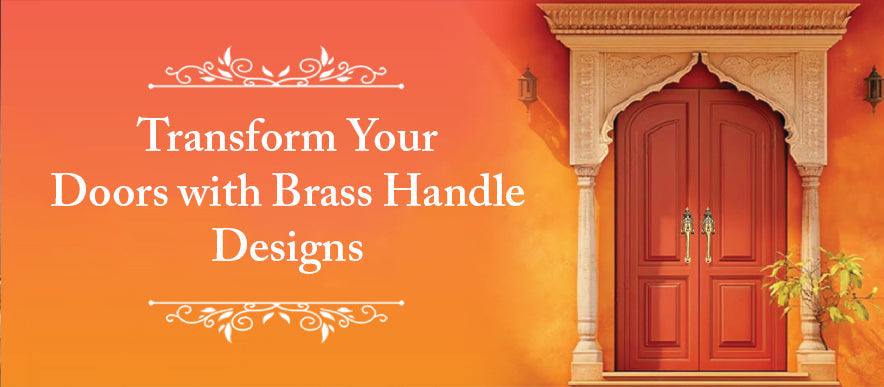Door handles can be like ordinary things, basic stuff we touch and do not remember. However, in reality, they can bring centuries of cultural heritage with them, making practical hardware a part of the narrative. No material has as much warmth in it as brass, with the durability, history, and alluring glow that changes with the years. Even brass door handles, specifically, are not mere design options; they are heirs to a tradition, the interiors, and mini-sculptures that are addressed to traditions and artistry.
Vintage brass handles turn a door into a living object, whether you want your interior to have tribal coziness, mythological splendor, or a sober antique charisma.
Also Read:- Crafted Elegance: The Artistry Behind The Indian Aura's Handcrafted Knobs
Why Brass Door Handles Speak of Centuries?

History in Your Hands
Handles made of brass are more than fixtures. They are physical links of the past and the present. The art of making objects using the brass medium was mastered by ancient Indian craftsmen and has become a tradition in the present. In your palm, each time you pick up a brass handle, you are holding a bit of tradition in your palm, a design refined in centuries of folk art and symbolic imagination.
The Power of Symbolism
Distinct from simple pulls or knobs, brass handles are frequently ornamented, with symbols: folded hands to welcome, the divine figure of Lord Ganesha to prosperity, the proud peacock to majesty, or the gentle camel to endurance. All themes are meaningful, based either on mythology, religion, or tradition. In this meaning, Handles are coded languages of houses that not only work, but also convey values, beliefs, and identity.
Brass as Living Art
The attractiveness of brass in interiors is that it is not fixed. Brass is unlike stainless steel or chrome and evolves beautifully with age. The contact, air, and time create a unique patina: dark brown honey, smoke tinges, and even green. This living finish makes each handle a one-of-a-kind, the years it has spent years in your house. This metamorphosis is, in fact, not a weakness, but this is what makes brass seem timeless.
Iconic Brass Handle Designs for Your Doors
Tribal Dhokra Motifs
Dhokra art is among the oldest metal casting traditions of India, which started in the Odisha and Chhattisgarh heartlands. This tribal heritage is directly drawn on the folded-hands motif of brass handles. The handles are often carved in shapes of male or female characters with palms that are intertwined in a Namaste- a welcoming sign that represents respect and hospitality.
Style & Feel: Organic, natural, grippy, rough, and a little solid.
Most Suited To: Wooden entrance doors, old-fashioned houses, rustic interiors.
Cultural Overtone: A greeting from a traditional village to your guests.
Aging Process: Acquires an enhanced texture with patina, highlighting its craftsmanship.
When you select Dhokra-inspired handles, you have put your everyday life in conversation with the folk traditions of India- every hold is a hug of tribal creativity.
The Ganesha Head Handle
Of all the motifs, Lord Ganesha has become the most popular in brass craft. Ganesha-shaped head handles combine spiritual and excellent craftsmanship components. They are also most popular with temple doors, pooja rooms, and doorways where protection and blessing are the most important.
Style & Feel: Detailed, chiseled, rounded shape, which offers a good grip.
Ideally Used In: Pooja room doors, temple alcoves, or entrances that have cultural themes.
Cultural Overtone: The object of wisdom, wealth, and divine blessing on the doorway.
Aging Process: Intensification of raised detailing and darkening of the brass ground increases the visibility of the features of Ganesha.
The Ganesha handle turns out not only to be hardware, but also a holy contact of your house.
Peacock & Camel Motifs
The peacock design is very grand, formal, and artistic in lavishness. The handle is often long and feathery, resembling the national bird of India, and carries the symbolism of royalty and attractiveness.
Style & Feel: Curvaceous lines make a comfortable grasp that is smooth, elongated.
Best Fitted: Heritage entries, formal living rooms, high symbolically stressing doors.
The camel handle, however, will attract the admirer of a reserved exotic beauty. It is inspired by the traditions of Rajasthan with rustic silhouettes inspired by the desert.
Style & Feel: Strong yet minimal forms, a firm grip with earthy character.
Best used in: Villa doors, country holiday house, and eclectic interiors.
Cultural Overtone: Symbol of survival, endurance, and travel through the ages.
Both handle styles underline storytelling: one majestic and celebratory, the other calm and resilient.
Myth & Modernity in Brass Patterns

Serpent-Shaped Handles
Snakes have complicated meanings in Indian and world mythology. Serpent handles are especially appealing and associated with change and security, and rebirth. Made with line flows and scale patterns, these sinuously run across the grip.
Style & Feel: Ridged grip that imitates scales; tapered long handle.
Most Apposite: Bigger doors, transition areas, feature doorways.
Cultural Overtone: Blend of protection and transformation; a guardian at the door.
Aging Process: Patina is used to highlight scales to make them look more mythical.
Victorian Beehive Door Knobs
Soaring across continents, the Victorian beehive knob is still one of the most identifiable European brasses. It was invented in the 19th century, and its ribbed spherical grip was made not only comfortable but fashionable. It is smooth to touch with an ideal ergonomic hold.
Style & Feel: Rounded ribbed shape, easy to hold, fully symmetrical.
Best Used In: Wardrobes, study doors, libraries, and bedrooms.
Cultural Overture: Sophisticated beauty of Victorian England; a reference to the world heritage.
Aging Process: Handles darken very well with contrasting polished ridges and tarnished grooves.
Minimalist Antique Finishes
In contemporary interiors where style has been superseded with simplicity, unlacquered brass pulls in antique decorations have subtle flair. The handles that were inspired by camels or snakes but redesigned in smoother forms suited the minimal houses, but had symbolic values.
Style & Feel: Slim contours, light relief design, light grip.
Best With: Modern apartments, wardrobes, and contemporary rustic interior.
Cultural Overtone: A subtle nod to tradition without overstatement.
Elderly Process: Acquires grayed patina, without being choosy or flaunting.
Craft, Finish & Care
Lacquered vs. Living Brass
The choice between lacquered and unlacquered brass defines how your handle will age. Lacquered brass maintains a constant sheen, requiring little maintenance but losing the evolving character of natural patina. Unlacquered, or “living,” brass evolves organically—changing tone each year, becoming more soulful with age.
Comfort & Grip
Beyond visual delight, brass handles are engineered for comfort. The weight of solid brass feels authentic in the hand, while carved forms (tribal figures, animals, or deities) double as tactile sculptures. Good craftsmanship ensures that no matter how ornate, the handle sits comfortably in your palm.
Caring for Brass Handles
Brass is low-maintenance. Regular dusting keeps it clean, while an occasional polish—once or twice a year—restores the gleam if desired. Many owners allow patina to develop naturally, finding beauty in the uneven darkening that narrates years of use. Unlike lighter metals, brass handles don’t bend or loosen easily, especially when thickly cast and properly mounted.
Final Thoughts
Conclusively, when one decides to turn the doors into vintage brass handle designs, the pieces one selects should radiate on an emotional level, should age, and relate to the past. Be it the folded-hands tribal motif of Dhokra, the nurturing serpent, the indulgent Ganesha, or the calm camel, all the handles bring home the contact with the past and your current interior. These are not mere door fittings, but rather artifacts that greet, tell, and remain.
FAQ
1. What is so special about the Dhokra-style brass handles?
Dhokra handles are created using the lost-wax casting age-old method of more than 4,000 years, carrying the tribal motifs such as folded hands and peacocks, which is absolutely unique in artistry and legacy.
2. What purpose is served by having brass patina upon exposure to atmospheric conditions, and why?
Brass oxidizes by itself with time, forming a natural patina that not only personalizes the handle but also makes it look kitschy.
3. Are brass knobs of decent quality?
The high durability and resistance to corrosion ensure that solid brass will not bend or break after decades of wear, even as it applies to high-traffic doors.
4. What can I do to take care of old brass handles to prevent the ugly face?
Dust often, polish rarely, but preferably allow the patina to mature naturally-with minimum treatment, life expectancy increases, and personality is maintained.
5. Are brass handles good for health and practicality?
Unlacquered brass is antimicrobial, naturally mitigating germs with time-which gives it not only ornamental, but hygienic benefits.

